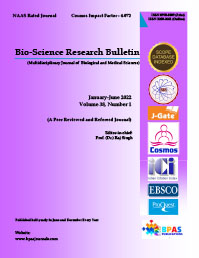Specialised Features of the Red Speckle Bean, Phaseolus Vulgaris
DOI:
https://doi.org/10.48165/Keywords:
Zea mays, dicots, water acquisition, seed coat, calcium, spermatophyte, elements, dormancy, dispersal, embryo, phaseolinAbstract
Phaseolus vulgaris is known as the common bean. This species is common in Africa and Asian countries, since it’s easy to grow. One of the specialised features of this bean is that it is grown in moist and well-aerated soils, as well as the fact that these seeds can easily be dispersed and germinated. A lot of research has been performed in Phaseolus vulgaris, and very little is not known about plant belonging to this genus. Classroom experiments in Phaseolus vulgaris are thus trustworthy and are well-discussed examples of the earlier work performed on the red speckle bean. This paper emphasises on the specialised features prevalent in beans of Phaseolus vulgaris.
References
Singh R. (2019). Personal communication. Republic of South Africa, my country. 2. Delgado-Salinas A, Bibler R, Lavin M (2006) Phylogeny of the genus Phaseolus (Leguminosae): A recent diversification in an ancient landscape. Syst Bot 31:779–791. 3. Gepts P, Osborn TC, Rashka K, Bliss FA (1986) Phaseolin-protein variability in wild forms and landraces of the common bean (Phaseolus vulgaris): Evidence for multiple centers of domestication. Econ Bot 40:451–468
Nwokolo E. (1996). Common Bean (Phaseolus vulgaris L.) In Legumes and Oilseeds in Nutrition (ed.) E. Nwokolo and Smartt J. Chapman and Hall. ISBN: 0412459302. 5. Petry N, Boy E, Wirth J P, Hurrell R F. (2015). Review: The potential of the Common Bean (Phaseolus vulgaris) as a vehicle for iron biofortification. Nutrients 7 (2): 1144-1173. 6. Singh SP (2001) Broadening the genetic base of common bean cultivars: A review. Crop Sci 41:1659–1675.
